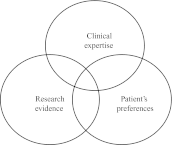Toward a transdisciplinary model of evidence-based practice
- PMID: 19523122
- PMCID: PMC2698591
- DOI: 10.1111/j.1468-0009.2009.00561.x
Toward a transdisciplinary model of evidence-based practice
Abstract
Context: This article describes the historical context and current developments in evidence-based practice (EBP) for medicine, nursing, psychology, social work, and public health, as well as the evolution of the seminal "three circles" model of evidence-based medicine, highlighting changes in EBP content, processes, and philosophies across disciplines.
Methods: The core issues and challenges in EBP are identified by comparing and contrasting EBP models across various health disciplines. Then a unified, transdisciplinary EBP model is presented, drawing on the strengths and compensating for the weaknesses of each discipline.
Findings: Common challenges across disciplines include (1) how "evidence" should be defined and comparatively weighted; (2) how and when the patient's and/or other contextual factors should enter the clinical decision-making process; (3) the definition and role of the "expert"; and (4) what other variables should be considered when selecting an evidence-based practice, such as age, social class, community resources, and local expertise.
Conclusions: A unified, transdisciplinary EBP model would address historical shortcomings by redefining the contents of each model circle, clarifying the practitioner's expertise and competencies, emphasizing shared decision making, and adding both environmental and organizational contexts. Implications for academia, practice, and policy also are discussed.
Figures





References
-
- American Association of Colleges of Nursing (AACN) The Essentials of Master's Education for Advanced Practice Nursing. 1996. Available at http://www.aacn.nche.edu/Education/pdf/MasEssentials96.pdf (accessed June 3, 2008) - PubMed
-
- American Association of Colleges of Nursing (AACN) The Essentials of Baccalaureate Education for Professional Nursing Practice. 1998. Available at http://www.aacn.nche.edu/Education/pdf/BaccEssentials98.pdf (accessed June 3, 2008)
-
- American Association of Colleges of Nursing (AACN) The Essentials of Doctoral Education for Advanced Nursing Practice. 2006. Available at http://www.aacn.nche.edu/DNP/pdf/Essentials.pdf (accessed June 3, 2008)
-
- American Association of Colleges of Nursing (AACN) AACN “Essentials” Series. 2008. Available at http://www.aacn.nche.edu/education/essentials.htm (accessed March 2, 2008)
-
- American Nurses Association (ANA) Nursing: Scope and Standards of Practice. Washington, D.C: 2004a.
MeSH terms
Grants and funding
LinkOut - more resources
Full Text Sources

